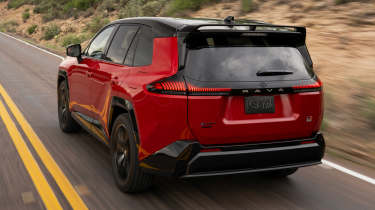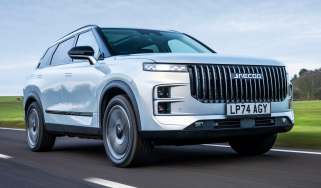New Toyota RAV4 GR Sport 2026 review: playful SUV has plenty to like
The all-new Toyota RAV4 SUV is an improvement over the model it replaces, but still falls short in some areas

Verdict
Toyota’s popular mid-size SUV has been overhauled with new styling and next-generation versions of the infotainment and plug-in-hybrid systems. The GR Sport trim level also does a better job of living up to its name with substantial chassis upgrades. Still, it feels like the 2026 RAV4 could’ve gone further to move the game on in a hyper-competitive class.
The 2026 Toyota RAV4 might look quite different, but beneath the skin is the same TNGA-K platform that underpinned the previous-generation car. The body has been strengthened and the suspension is new, but the dimensions are virtually the same.
In the US, where the RAV4 is the best-selling thing that’s not a pick-up truck, those dimensions make it a ‘compact’ SUV. But in the UK, it utterly dwarfs its next-smallest sibling (the C-HR) by nearly 300mm. It’s also about 100mm longer than a Kia Sportage or Volkswagen Tiguan.
Despite the carry-over platform, the new RAV4 gets Toyota’s next-generation plug-in hybrid powertrain. While other markets get a traditional hybrid powertrain standard, the UK will be PHEV only, just as it was towards the end of the previous model’s life. A higher-capacity, 22.7-kWh lithium-ion battery helps increase all-electric range to an estimated 60 miles – up from 46 miles on the old car.
Used - available now
The plug-in powertrain can now be paired with front-wheel drive, but as that means losing the AWD-enabling rear motor, total output falls to 264bhp. With four-wheel drive, total system output has actually dipped a bit to an even 300bhp (it produces 320bhp in North America), but Toyota says the 0-62 mph time has fallen by two-tenths of a second to 5.8 seconds.
The difference between the PHEV and the regular, “self-charging” hybrid is profound. On our test drive we found that when the battery is fully charged, it accelerates like an EV – smooth, punchy, quiet. The standard hybrid powertrain may be smoother and punchier than before thanks to a similar set of upgrades, but it’s not what we’d call quiet, groaning under heavy throttle. As the PHEV relies more heavily on its electric motors, even when the plug-in portion of the battery is depleted, the engine doesn’t sound quite as strained.
While the aforementioned tweaks to the structure and suspension have made the 2026 RAV4 feel more refined and controllable, the GR Sport trim level goes even further, with significant upgrades over the glorified appearance package it replaces.
Developed in collaboration with Toyota’s Gazoo Racing wing, the new GR Sport model gets retuned steering, upgraded and strengthened suspension components, a 15mm-lower ride height and wider 20-inch wheels that altogether provide a significantly different, and better, drive than the standard set-up.
Body motions are reduced and the more precise steering is free from the numb on-centre feel and elastic-band-like turn-in that plagues other models in the new RAV4 range. We didn’t think the ride quality suffered versus other models in the range fitted with 20-inch wheels.
Inside, the nearly unchanged dimensions mean the back seat remains a bit smaller than some rivals, but we found it’s still ample enough for adults and rear-facing child seats. Boot space is up ever so slightly, and while the floor isn’t entirely flat (it ramps down towards the sill), you’ll be hard pressed to find a bigger load area in this class. Plus, unlike so many other electrified SUVs, our US-spec test model featured a valuable spare tyre under the floor.
Interior design and quality seem to have taken a hit, however. Even top-end trims are awash with hard black plastic and Toyota has stripped away the old RAV4’s metal-look inserts and available splashes of color. The result is ugly and a bit depressing, even with the GR Sport’s token red stitching and logos. Carving a big hole in the dash for a double phone-holding bin doesn’t exactly improve aesthetics, either, and worse, has relegated the climate controls to the touchscreen. While better than many in this regard (temperature is adjusted with physical buttons), they still draw too much attention away from the road.
Other touchscreen changes are more positive, as the RAV4 debuts Toyota’s next-generation tech interface. Now measuring 12.9 inches, it gains a homescreen with customisable menu icons, correcting an irritating omission of the current system, and making it that much easier to quickly navigate the various menus. Toyota tells us it has improved the voice commands, and underpinning it all is an all-new software platform that also powers the various upgraded driver-assistance technologies.
A 12.3-inch digital instrument panel is also now standard, bringing with it the typical array of layout options, including, for the first time in a Toyota, a navigation map view. The Excel and GR Sport also gain a head-up display.
All told, the 2026 RAV4 is better, but hardly revolutionary. You can sense the old one’s bones lurking under the skin. The GR Sport is the outlier, though. It may not elevate the RAV4 to the performance level of a GR Yaris (would anyone actually want that?), but it’s sharper enough that B-road drives may actually be enjoyed rather than simply completed.
Did you know you can sell your car through Auto Express? We’ll help you get a great price and find a great deal on a new car, too.
| Model: | Toyota RAV4 GR Sport PHEV |
| Price: | £45,000 (est) |
| Powertrain: | 2.5-litre 4cyl petrol PHEV |
| Power/torque: | 300bhp/N/A |
| Transmission: | CVT automatic, four-wheel drive |
| 0-62mph: | 5.8 seconds |
| Top speed: | 112mph (est) |
| Economy/CO2: | TBC |
| Size (L/W/H): | 4,646/1,854/1,684mm |
| On sale: | Spring 2026 |












